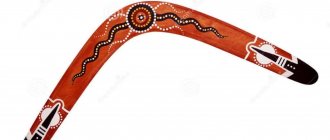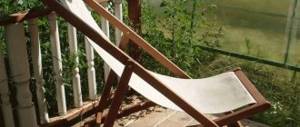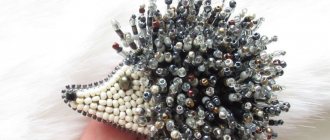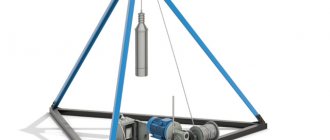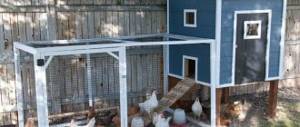- GENRES 360
- AUTHORS 258 944
- BOOKS 595 234
- SERIES 22 281
- USERS 557 056
Improved model (P.G. Kunin)
The rational analyzer proposed an original solution: to prevent moistened soil from sticking to the shovel, he cut technological “windows” in the blade.
Plus, the tool has become noticeably lighter and goes much deeper into the ground.
Shovel for those suffering from chronic radiculitis (V.Ya. Dedo)
In an “anti-radiculitis” shovel, the handle is attached to the blade at an angle of approximately 140°. At the very top there is a hole drilled into which a loop for the hand is threaded.
Shovel for those suffering from radiculitis.
1 – metal cable, 2 – handle, 3 – hand loop, 4 – handle, 5 – blade.
It looks like a ski pole. In the upper part, in the corner of the blade, 2 holes (8 mm in diameter) are drilled. A metal cable ending with a handle is inserted into one of them. The length of the pull is equal to the distance from the bent fingers of the lowered hand to the lapel (when it is dug into the ground). The process of working with an “anti-radiculitis” shovel looks like this: the blade of the shovel is driven into the soil by pressing the left foot. Then, with the movement of the left hand, they lift it slightly, but do not lift it off the ground. Afterwards the working part of the shovel is turned over; the soil falls away.
The advantages of working with such a tool are that a person does not lift a shovel with soil, as usual, but moves it somewhat to the left of himself. Back pain is practically not felt. In order not to overcook the pipe to the required angle of attachment, instead of a straight handle, you can take one already bent to the desired shape.
Hoes, weeders, rippers
The traditional hand tool for tillage is the hoe. Most often it is made in the form of a triangular plate, riveted or welded to a sleeve, which is put on the handle.
The design of this ancient farmer's tool is extremely simple and surprisingly rational. Nevertheless, craftsmen are modernizing this instrument. As the name of the device implies, weed weeders are designed to destroy weeds both in the rows and in the beds. They can be plate or loop.
Plate weeders are equipped with a blade 5–8 cm wide. To make them, it is recommended to use an old hacksaw blade: it is light and practical because it does not require frequent sharpening.
Loosening the beds in the garden or the soil in the garden is a necessary, but labor-intensive and tedious operation, especially for older people. Simple adaptations to conventional earthen implements, proposed by innovators, and homemade tools, which they use when cultivating garden plots, help to facilitate this work.
Compared to a single one, it reduces fatigue when weeding and increases labor productivity. You can weed with such a hoe both along and across the bed. The main thing is to position the cutting in relation to the ground at an angle of 45°. This hoe consists of 2 knives sharpened on both sides. They are welded to brackets attached to a tubular flyer.
Why are garden shears needed? Main purpose of the tool
This tool should be classified as a hand tool. It is used to correct the length of shoots and thin branches. Used when caring for shrubs, grapes and tree crowns. Mostly necessary for landscaping the site and cutting off dried plant branches.
A standard pruner consists of the following elements:
- working blade;
- bolt;
- nuts;
- springs;
- support blade;
- buffers;
- castle;
- handles.
The success of a pruner is determined by the performance of the blade and its good cutting characteristics. The angles of the blade should be sharp to easily cut through plant stems, branches and other parts. Thanks to this, the process becomes correct, and the cut will ultimately be clean and smooth.
Important! The bolt must be tightened very tightly to ensure maximum operating torque.
After trimming, the spring facilitates the smooth return of the pruning shears to its place. Incorrect pressure can lead to breakage of the part, which will lead to malfunction of the tool as a whole. The support blade is slightly curved to reduce friction. There is a special dent on it through which juice flows.
But the lock helps to fix the pruning shears in their original position. This way you can avoid damage to the blade, as well as prevent the formation of any injuries.
Sharpening pruning shears at home step by step
1. Bar
First of all, prepare the bars. You will need three bars with different grains: large, medium and fine. Of course, it is better to purchase high-quality sharpening objects, but the simplest, cheapest options are also suitable for pruning shears. It is most convenient to take the one with a large grain on one side and a medium one on the other. The bars can be replaced with sandpaper, but not on a paper basis, but on a woven one. It will need to be fixed on some kind of solid base. For example, wrap a wooden board of such a size that it is comfortable to hold in your hand. “Sandpaper” is also selected with different grains, coarse to fine.
2. Screwdriver, pliers, machine oil
You will need them to disassemble the instrument. And after all the work, do not forget to lubricate the pruning mechanism
Similar chapters from other books
Gardening scissors
Garden shears Garden shears (Fig. 6) are as indispensable tools for working in the garden as any other. Rice. 6. Garden shears Scissors are mainly used for removing thin branches, cutting cuttings, cutting flowers, decorative trimming of bushes and trees.
Timing of pruning
Timing of pruning The duration of the pruning season is determined by the biological characteristics of breeds and varieties and the weather conditions of the area. The main pruning is carried out in the cold season in the absence of plant vegetation. Pome-bearing species in a state of growth dormancy
Pruning technique
Pruning technique For trees, depending on their age and varieties, the pruning system is determined annually. The density of the crowns, the strength of growth, the type of fruiting, etc. are taken into account. If the strength of growth is small, especially in young trees, this may be the result
Timing of pruning
Main purposes of pruning
The main goals of pruning are the health and longevity of plants - sanitary and rejuvenating pruning, which is used for all plants, regardless of their role in the garden. At the same time, if sanitary pruning is a mandatory component of comprehensive care, then the question of
A small modification to the garden pruning shears
Hello to DIYers, as well as summer residents and gardeners!
Now is the time for spring pruning of garden trees and shrubs. In this case, of course, it is impossible to do without garden pruners. But, as you know, pruning shears (like many other tools) require periodic disassembly for sharpening, lubrication, etc.
So this spring I decided to disassemble my pruning shears in order to sharpen, lubricate and adjust it, since over the previous few years of work it had become dull and a little loose.
I must say that my pruning shears are German and of very good quality. I bought it 7-8 years ago, and since then it has served me well. Moreover, I disassembled it only once during this time, to sharpen it and lubricate it with thick lubricant.
However, as far as I remember, even then, when first disassembling the pruning shears, I encountered the problem of unscrewing and tightening the screw on its working axis.
The fact is that usually the axle on pruning shears is made in the form of a rod or bolt with a thread at the end, onto which a nut is in turn screwed. A pruner with this design is very convenient to disassemble and adjust, since to do this you just need to unscrew or tighten the nut using a regular open-end wrench.
However, on my German pruning shears, the axle is made in the form of a hollow bushing with an M5 screw screwed into it, which, in fact, secures the axle and the entire assembly assembly. At the same time, on the head of the screw for unscrewing it, slots are made (as on a regular screw) for a Phillips screwdriver.
However, the splines in this design are very unreliable. And to be honest, I don’t understand why the German designers didn’t make the screw with a hex head in this case. It would be much more practical and reliable.
As a result, when I began to disassemble my pruning shears for the second time and tried to unscrew the screw with a Phillips screwdriver, the slots began to deform and break off.
As a result, I had to use pliers to unscrew the screw.
Naturally, after I disassembled the pruning shears in this way, I was faced with the problem of repairing or modifying the screw head so that in the future I could use the pruning shears normally.
And then I decided to take the simple route and simply grind the screw head on both sides so that it could be unscrewed and tightened with a regular wrench.
For this I needed: an electric sharpener, pliers, and a 7 mm wrench.
To make it more convenient to hold the screw during processing, I screwed it back into the sleeve, like into a kind of mandrel.
And then, holding this sleeve in pliers, I ground the screw head on both sides on a sharpening wheel.
And this is what I got!
As you can see, the screw head now fits perfectly with a 7mm wrench.
After that, all I had to do was thoroughly wipe all the parts of the pruner, clean it of old grease and sharpen its cutting parts.
I will not describe sharpening pruners here, since there are many videos about this on YouTube, and anyone who needs it can find it and watch it in detail there.
Then I assembled the pruning shears, having previously lubricated its axle and rubbing surfaces.
At the same time, under the head of the screw, I additionally placed a washer from an M5 bolt for reliability.
After assembly, all I had to do was tighten the screw head with a wrench.
Well, now you can try out the pruning shears in action.
To start, I tried cutting cardboard and paper. The secateurs did a great job.
Then I tried the pruning shears on a thin branch. The pruner also did an excellent job with this job. As you can see in the photo, all the cuts are very even.
So now my pruner is completely ready for use.
And most importantly, now it can be easily disassembled and assembled, and can also be easily adjusted using a regular wrench.
Well, that's all for me! Wishing everyone a sharp, high-quality and reliable tool!
Processing the secateur spring
After processing the blades, the pruning shears are assembled again. When assembling the tool, use a screwdriver to tighten the screw that secures the spring. Then the spring is lubricated with machine oil. A special lubricant is supplied with branded pruners.
After lubricating the spring, it will be easier to work with the pruning shears. When pruning trees, you will use minimal effort. The sharpened blades of the pruning shears will make an even cut on the branch without “chewing” the bark. Therefore, the cuts will tighten faster.
When pruning fruit trees and berry bushes, use garden varnish to prevent liquid gum from forming on the cuts.
After preparing the pruners for work, you will significantly increase your productivity and process plants faster. If the blades of your pruning shears are too rusty, take the tool to a repair shop to have the blades cleaned of rust or replaced.
Features of the Belarusian pruning shears for grafting trees
Belarusian grafting pruners, today, are characterized by amateur gardeners as one of the most reliable, easy-to-use, durable and high-quality tools. They have a typical design and have the following parameters:
- the movement of the knife blade is carried out in a perpendicular direction to the handle;
- the working part is made of high-strength and modern steel ST-20 coated with white zinc;
- The knives are made of high-quality tool steel;
- the handles are made of reliable steel alloy with silicone coating;
- total weight does not exceed 0.45 kg.
The material of the handles is comfortable and easy to clean with a regular soap solution. The thickness of forged knives with double-sided sharpening is 0.3 mm. A special feature is the minimal gaps, as well as almost completely absent play in the moving part of the grafting drive.
